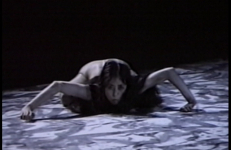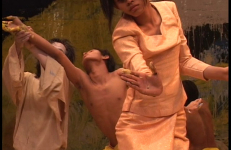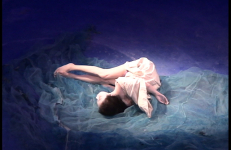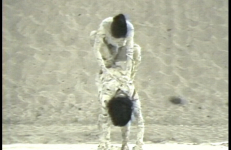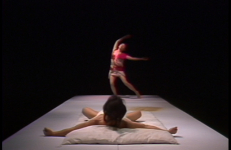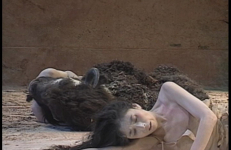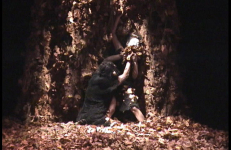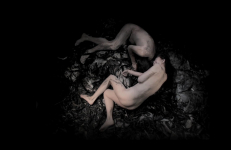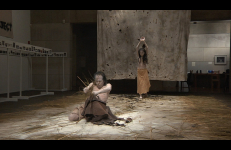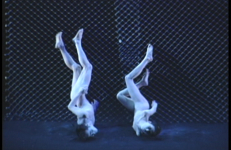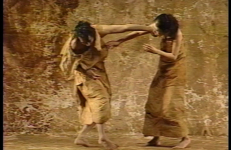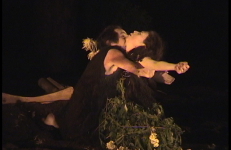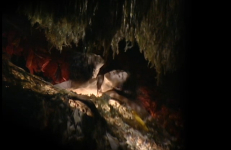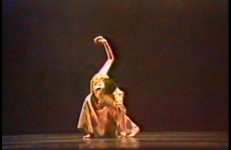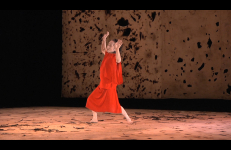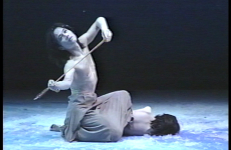Commissioned by Boston Dance Umbrella, this work was created during a month-long residency in Boston. Clayton Campbell painted a mythological scene of the river that a dying person crosses to reach the world of the dead. The piece was first titled as Eye Below but later changed to By The River.
Eiko & Koma: Stage and Site Works
Cambodian Stories is Eiko & Koma's multi-disciplinary collaboration with Reyum Painting Collective, young painters who study and work at the Reyum Institute of Arts and Culture in Phnom Penh, Cambodia. In addition to Eiko & Koma, who perform alongside their Cambodian artist colleagues, the creative collaborators include Reyum Institute founder Daravuth Ly, who functions as dramaturg, and Cambodian-born music ethnologist Sam-Ang Sam.
Co-commissioned by the Dance Center of Columbia College Chicago and Danspace Project, Death Poem is a meditation on dying. Eiko dances a long solo on a futon under a mosquito net, accompanied by the sound of insects and cicadas. Koma enters from another world and tries to bring Eiko back with him, but he leaves without her, as she is not yet ready to go.
Event Fission is an outdoor performance on the Hudson River landfill, produced by Creative Time. Eiko & Koma danced with a huge white flag billowing on top of a sand dune as the audience watched from below. The white flag was used to symbolically attack the newly developed downtown buildings. On a lower level of the landfill, to which Eiko & Koma tumbled down, there were fires on four corners of the performing area. At the end of the performance of 50 minutes, Eiko & Koma were swallowed into a deep hole they had dug and hid, disappearing with a blast of sand.
Created at Eiko & Koma's home in the Catskills and set to Gamelan music, Grain was first presented during a month-long season in an East Village loft. Charles and Stephanie Reinhart were among the ten audience members one night and invited Eiko & Koma to the American Dance Festival that year. Since then, the work toured widely.
Co-commissioned by the Next Wave Festival, The American Dance Festival, and the Lied Center at the University of Nebraska, Land is a collaboration with Native American musician Robert Mirabal and painter Sandra Lerner. Robert and his cousin and drummer Laynold Lujan live in Taos Pueblo, New Mexico, where Eiko & Koma conceived this work. Not only did Eiko & Koma visit Taos repeatedly but Mirabal also spent three months in Japan and visited the East Coast several times for this collaboration.
An evening-length collaboration work with the celebrated avant-garde pianist Margaret Leng Tan. The stage set is by Eiko & Koma and the lighting is by David Ferri.
Commissioned by and premiered at Japan Society, New York, October 18-20, 2007, celebrating Kazuo Ohno's 101th Birthday and the 100th anniversary of Japan Society.
Naked is a "living" environmental installation created for and commissioned by the Walker Art Center in Minneapolis, where EIko & Koma were "on view" all the hours the museum was open for the month of November 2010. Eiko & Koma performed the total of 144 hours.
Designed as the centerpiece of Eiko & Koma’s three-year Retrospective Project, Raven is a radically scalable work. It can be performed in a theater, a gallery, outdoors, or at any other special site, and its length can vary depending on the context of the presentation. Raven’s genesis is in the concept underlying Eiko & Koma’s 1991 Land. The earth is precious in part because it can be unyielding. The landscape does not squander its riches on us; we have to negotiate our survival.
Rust was commissioned by the American Dance Festival and performed on chain-link fences hung vertically in the center of the stage. Performed nude in silence.
Their first longer piece entirely in silence. The backdrop and floor were painted with a burned flour paste which crumbled down as they moved. In bright light, Eiko & Koma became thirstier as the four sections progressed, seeking both water and intimacy in an extreme setting.
In Tree Song, Eiko & Koma continue their exploration of the body as a part of the landscape and the landscape as an extension of the body. Trees have been symbols of resilience, rebirth and portals through which spirits pass. Tree Song honors the iconography of trees and the primal mysteries of landscape and the human body.
Commissioned by and performed at the 2000 Brooklyn Academy Music Next Wave Festival, When Nights Were Dark is a full evening-length collaboration with Joseph Jennings and the Praise Choir. The work was created during a Lower Manhattan Cultural Council residency which allowed Eiko & Koma the full time use of the studio on the 91st floor of the World Trade Center North Tower throughout 2000. The décor of The Caravan Project was hugely expanded for this work and placed on a slowly turning wheel.
Eiko & Koma titled all of their performances in Europe White Dance (1972-1974). Their presentations were always about one hour, performed without an intermission. In naming their program White Dance, Eiko and Koma were trying to create a new beginning for themselves, not bound to the butoh works of their teachers Hijikata and Ohno, which were often described by the artists themselves as “dances of darkness.”
Revived as part of the Retrospective Project, White Dance is the first piece that Eiko & Koma performed in America.
Wind imagines a dying child, a common event until recently and still so in many parts of the world today. This was a collaboration with Chanticleer music director, Joseph Jennings, who arranged a composition by Robert Mirabal and Francisco Guerrero. It was performed live by Chanticleer in San Francisco and specially recorded for tour. Eiko & Koma’s two sons, Yuta and Shin, both played the role of a boy in the piece. The floor was painted to look like a galaxy and white feathers fell from the ceiling, making a sense of wind visible.




